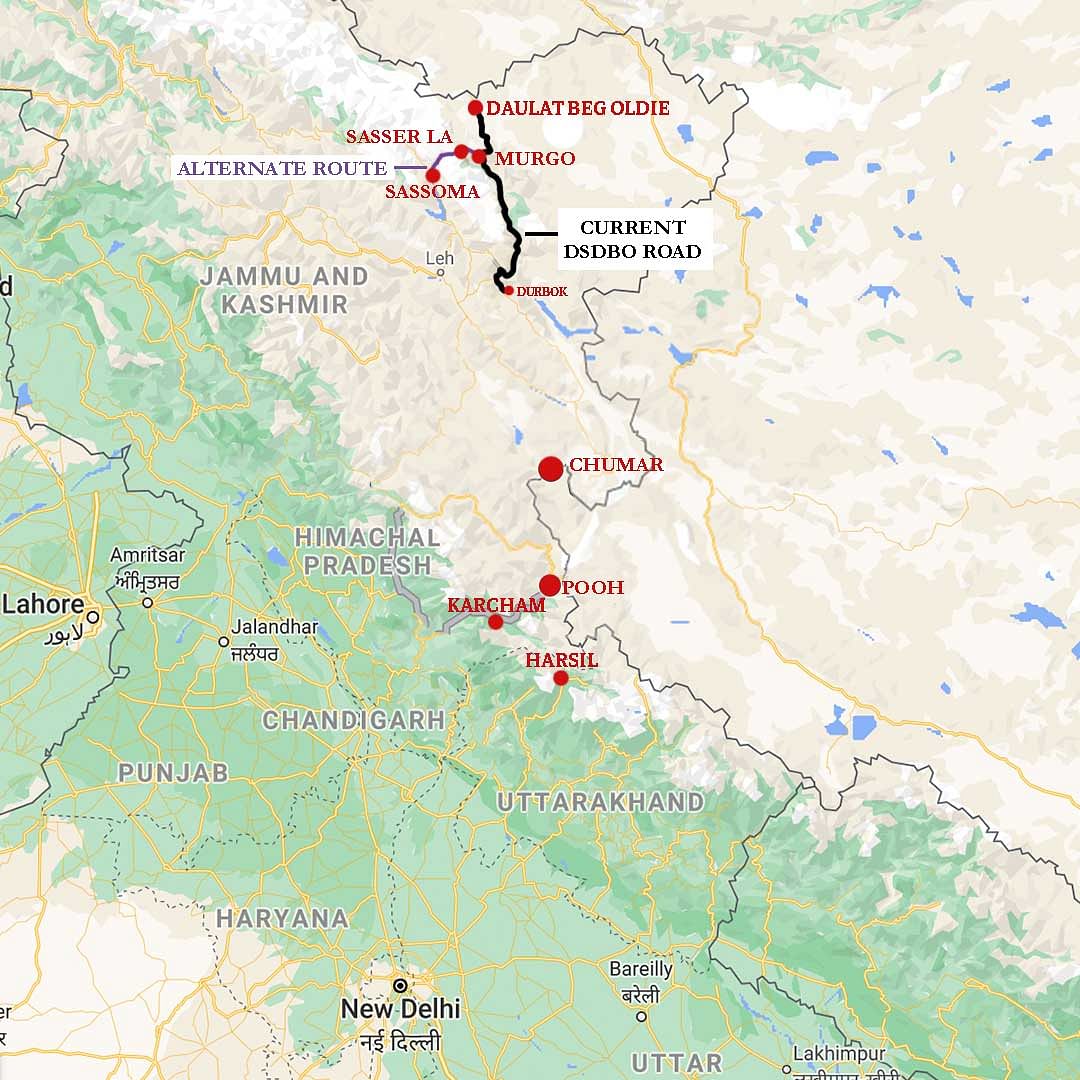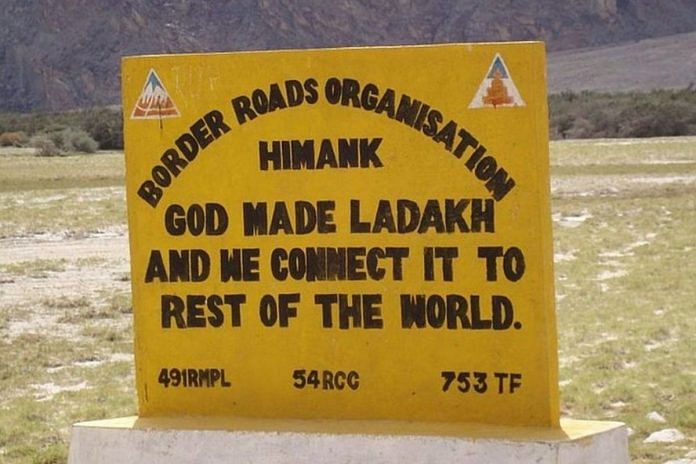New Delhi: The Narendra Modi government is planning to expand the motorable network along the India-China border by building two news roads — one connecting Pooh in Himachal Pradesh to Chumar in Ladakh, and the other linking Harsil in Uttarakhand to Karcham in Himachal Pradesh.
It has also stepped up work on an alternate road being built to Daulat Beg Oldie (DBO), where India’s highest airstrip is located, in eastern Ladakh.
The moves come amid the four-month-long stand-off between Indian and Chinese troops at the Line of Actual Control (LAC) in Eastern Ladakh.
The Border Roads Organisation (BRO), under the Ministry of Defence, will be constructing all three roads.
The two new roads are not part of the 73 India-China Border Roads (ICBRs) planned for brisk movement of troops and weapons — a project already under way.
Government sources told ThePrint that both roads will be around 150-km long, and that construction would be a tedious task given that it would involve cutting through multiple passes.
The roads are expected to cost around Rs 2,500 to Rs 3,000 crore each.
Also read: ‘Words need to turn into action’ — soldiers not impressed by China peace talk with Jaishankar
Stepping up border mobility
It is understood that once constructed, the roads will turn out to be major infrastructural assets along the India-China border. They will provide additional flexibility to the deployment of troops along the LAC and also allow a faster switching of their locations.
At present, it takes nearly 20 hours by road to traverse the 720-km long distance between Pooh and Chumar. Harsil and Karcham are separated by nearly 450 km, a distance that takes over 16 hours to cover.
Pooh is a strategically important town located just 18 km by road from the LAC, while a key military post lies at Chumar along the LAC, south east of Pangong Tso.
A road between these important locations would allow easier switching of troops between Ladakh and Himachal Pradesh and greater domination of the LAC in this area.
Harsil and Karcham are about 52 and 26 km, respectively, from the border with China.

‘Focus on faster construction of alternate road to DBO’
A second senior government official told ThePrint that the faster construction of the alternate route to DBO remains the government’s top priority.
This alternate road in Eastern Ladakh will start from Sassoma along the Nubra river to the vital locations of Sasser La and Gapshan before joining the existing route to DBO. It will be in depth and away from immediate domination of the Chinese. Sassoma is nearly 90 km from DBO.
Sasser La is situated at a height of nearly 18,000 ft — even higher than the Khardung La pass — while Gapshan is located in a valley that subsequently joins the existing DS-DBO road.
The existing Durbuk-Shyok-DBO road — which runs literally along the LAC — is 255-km long and is currently the only road to reach DBO. It has 47 bridges on it.
The official said this alternate road would increase road space and permit more vehicles to ply on a regular basis, and hasten military movements.
“Part of this alternate road is already complete. Sassoma to part of Sasser La has already been blacktopped and is a motorable road. Sasser La onwards is a mud track which is being planned to be blacktopped,” the official added.
A third senior government official told ThePrint that this alternate road will be of huge strategic importance especially in the wake of Chinese threat at the LAC.
“In case there is an attack on the vital logistics supply route to DBO (the existing road), this route will be away from the direct enemy line of sight and delay detection of troops and logistics movement,” the official said.
Also read: Army to add bite to LAC defence, is training native Ladakhi dogs for operational roles
Multiple road networks across eastern Ladakh, Northeast
The BRO has been constructing multiple road networks and strengthening the existing road infrastructure connecting the forward locations of Pangong Tso and others through eastern Ladakh.
While there were reports that it is the building of specific roads in eastern Ladakh that peeved the Chinese leading to the current standoff, government sources said fresh construction and strengthening of existing infrastructure such as roads and bridges have been taking place for quite some time.
Simultaneously, a fourth of the BRO’s 32,000-strong staff is in Arunachal Pradesh to strengthen the road infrastructure there, which will not only help the civil population, but also in moving the military at a faster pace.
While the BRO earlier had been questioned repeatedly over the inordinate delays in the construction of the identified border roads, government officials said the pace has increased substantially in the last few years.
The BRO built close to 10 bridges last year on the roads in eastern Ladakh alone.
Under the India-China Border Roads (ICBR) programme conceptualised in the late 1990s by the China Study Group — and subsequently cleared by the Cabinet Committee on Security for construction in 1999 — a total of 73 roads measuring 4,643 km had to be constructed along the China border.
Of them, 61 such roads of strategic importance were to be constructed by the BRO and 12 were to be built by the Central Works Public Department.
According to data available with ThePrint, of the 61 roads — spread across Jammu & Kashmir, Ladakh, Himachal Pradesh, Uttarakhand, Arunachal Pradesh and Sikkim — BRO has reportedly completed 40 roads and 12 more roads will be completed by March 2021.
The BRO’s budget was nearly stagnant at Rs 4,000 crore between 2009 and 2015, before jumping to Rs 5,400 crore in 2017-18. It has now reached Rs 11,000 crore for the 2020-21 fiscal.
Also read: India-China endgame in Ladakh looks costly unless both Modi and Xi get a face-saver deal




Is there any way the our government and armed forces can arrange for pre-fabricated cement bunker for our soldiers in the areas like helmet top etc. These bunkers can be constructed at base and airlifted to site. https://commons.wikimedia.org/wiki/File:A_bunker_in_Albania.JPG
This will really help our solider survive the winter.
Sense has prevailed in the government and bureaucracy regarding roads being essential to keep up our territories being swallowed by Chinese expansionism.
Without such roads our border states like HP, Arunachal, ladakh, Sikkim etc. are very vulnerable.
Despite the alternate route to DBO, final stretch of the route is same ie the road from Murgo to DBO via Depsang. On this stretch any armed forces movement will be like sitting ducks for PLA incursions from the Aksai Chin salt flats.
So, these roads’ networks will really help in countering the threat eminent from the Chinese cyber space warfare.. We are literally two decades younger in our approach ..